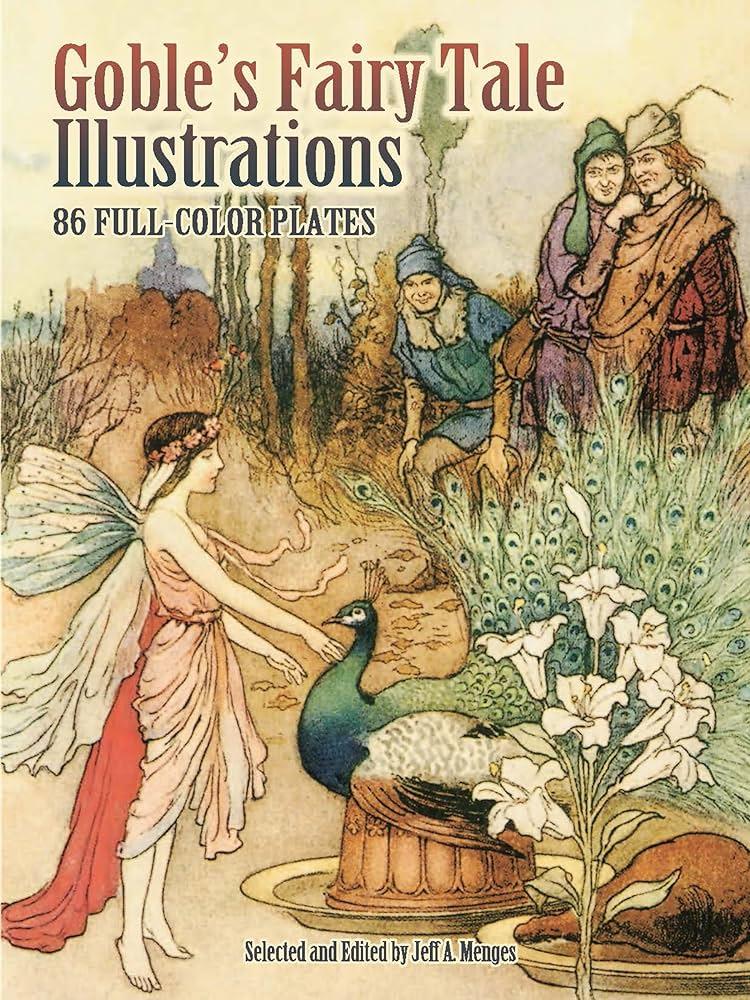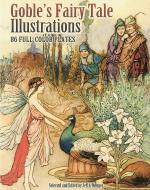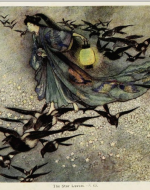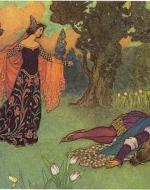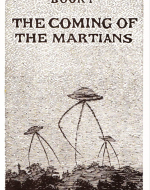Created by Grace Mahon on Fri, 03/08/2024 - 11:16
Description:
Warwick Goble, a prominent British illustrator of children’s books, was born in Dalston, London on November 22, 1862. From a young age, he showed a deep artistic passion, which his family supported, as he received guidance from his father, a commercial artist. Goble continued to hone his craft first at the City of London School and then at the Westminster School of Art. He flourished and, in his twenties, embarked on his professional career as a magazine and book illustrator. Quickly gaining recognition for his beautiful illustrations, which depict vividly colored fantastical elements inspired by Japanese, Indian, and Arabic art, Goble honed his craft. His major breakthrough occurred in 1892 when he worked on the illustrations for Fairy Tales by the Brothers Grimm alongside H. R. Millar, a prolific Scottish artist (Goble, Sandie). This publication highlighted Goble’s immense talent and established his reputation as one of the most skilled illustrators of his time. His career only continued to grow, inspiring generations of children and adults alike. Today, Goble is best known for his work for H.G Wells’s War of the Worlds (1897). Given his talent for ethereal fairy tales and beautiful princesses, his dive into science fiction was unexpected at the time. The novel, one of the earliest and most influential works in the science fiction genre, has since been adapted into films and television. Other prolific illustrators, including Edward Gorey who was influenced by Goble, have also taken up the task of illustrating the pioneering novel. From classical fairy tales to science fiction, Goble serves as a reminder that illustration has the power to transcend time.
Cover of Goble’s Fairy Tale Illustrations: 86 Full-Color Plates, Dover Fine Art, 2008, courtesy of Joseph Beth Books. As there are no pictures of the talented Illustrator, I have chosen to represent the artist via a book cover of Goble's Fairy Tale Illustrations. I found this image digitally from Joseph-Beth Booksellers' online website.
Warwick Goble, "Star Lovers,’" for Green Willow and Other Japanese Fairy Tales," by Grace James, 1910, London, Macmillan, digitized 1 Jan. 1970. Green Willow and Other Japanese Fairy Tales was written by English author and translator, Grace James, who specialized in compiling fairy tales from diverse cultures. She is best known for her work in translating and adapting Japanese folktales and fairy tales for English-speaking audiences. Warwick Goble illustrated several works that featured Japanese folktales and fairy tales, such as "The Star Lovers" (Tanabata) and other stories from Japanese mythology, which can be seen in the internet archive of the book. Published by Macmillan and Co., this collection showcases tales selected from various sources, including the Ko-ji-ki, Japanese mythology's Record of Ancient Matters. Electronically published in 1970, this particular edition transcends Goble’s life, as he died in 1943. It is unknown exactly when Goble illustrated this specific tale. "The Star Lovers" was likely done sometime from the late 19th to the early 20th century, influenced by the Japonisme movement taking place at the time. Japanese art became popular for Westerners when Japan ended its isolationist policies in the mid-19th century, and Goble’s illustration reflects the period of cross-cultural appreciation and artistic innovation. The beautiful illustration captures the celestial romance between Vega and Altair, separated by the Milky Way and reunited annually during the Tanabata festival's seventh lunar month when the skies are clear.
Warick Goble, "Beauty and the Beast," 1913, by Gabrielle-Suzanne de Villeneuve, The Fairy Book, Wikipedia. Goble added his illustrations to The Fairy Book: The Best Popular Fairy Stories Selected and Rendered Anew by Dinah Maria Mulock Craik, in 1913 after its first publication in 1863. In his illustration, he depicted a "pregnant moment," a term attributed to G.E. Lessing that hints at the past and future in the present moment. Goble shows us the Beast just before he transforms into the Prince. In this scene, Beauty, having a poignant dream of the dying Beast, rushes back to find him apparently lifeless. Overwhelmed with remorse and love, she revives him, realizing her true feelings. As she declares her love for the Beast, he transforms into a handsome prince, liberated from enchantment, and they celebrate together in their newfound happiness. The illustration portrays a man with the head of a boarlike beast, foreshadowing his imminent transformation into the Prince. Goble’s significant contributions to The Fairy Book infused visual depth and enchantment into retellings of classic tales by renowned English author and poet Craik. Warwick Goble’s illustrations, characterized by rich colors, intricate details, and a whimsical style, perfectly complement the magical themes of the beloved tales. The Fairy Book curated a selection of popular fairy stories including "Cinderella," "Sleeping Beauty," "Snow White," and "Jack and the Beanstalk" illustrated anew. The book captured the Victorian fascination with fairy tales and folklore, and Warwick Goble’s enchanting illustrations further deepened this fascination.
Warwick Goble, "They Were All Stalking Seaward, for The War of the Worlds, by H.G. Wells, 1897, The Victorian Web. In 1896, Goble began to gain recognition for illustrating H.G. Wells's The War of the Worlds. Wells himself first published The War of the Worlds serially and sold the rights in the same year. Between April and December 1897, both Pearson’s Magazine in the U.K. and The Cosmopolitan in the U.S. serialized the story, featuring illustrations by Warwick Goble, as noted in Encyclopædia Britannica. These magazines played crucial roles in shaping public discourse and reflecting cultural trends of the time, attracting wide readerships and helping shape literary tastes in the United States. Goble’s illustrations for The War of the Worlds broke new ground, approaching the text with confidence and crafting startling, innovative illustrations that closely matched Wells's descriptions. These illustrations sharply contrasted with his typical fairytale-esque style, arguably representing his best designs from this period. They depicted an unnerving Martian invasion, diverging significantly from his previous works centered around themes of love. It's worth noting that the original illustrations were in watercolor and gouache, but the available images are grayscale reproductions of the originals. However, despite the absence of color, Goble’s illustrations demonstrate his talent in narrative art. This is particularly impressive considering the novelty of the science fiction genre at the time, with Goble having no reference but his imagination. Simon Cooke, Assistant Editor for Book Illustration and Design of The Victorian Web, observes, “Goble’s dynamic and overpowering designs for The War of the Worlds have had a much wider significance than he, or his contemporaries, might have imagined.”
Edward Gorey, “The Coming of the Martians,” for The War of the Worlds, by H.G Wells, 1960, by Maria Popova, The Marginalian. The War of the Worlds and Goble’s illustrations have left a lasting impact on the modern world and its renowned artists, including Edward Gorey. Gorey, an influential American writer and illustrator known for his distinctively macabre style, gained fame for his drawings, often featuring Victorian themes. Born in 1925, Gorey spent seven years working in Doubleday's Art Department in New York City from 1953 to 1960. Towards the end of his time there, he illustrated a special edition of H.G. Wells's The War of the Worlds for the Looking Glass Library series (Popova). Gorey's distinct style suits the story well; his talent for illustrating haunting figures matches H.G. Wells' tale of Martian tripods descending upon humanity. The text oscillates between realism and the absurd, unsettling readers. The tale's irony brings to light the phrase "Gorey's dark side comes to the fore" (Open Culture), much like science fiction sheds a different light on Goble, previously known for his fairy-tale illustrations. Unlike Goble's traditional drawings, Gorey's eerie and surrealistic illustrations are known for unnerving the viewer. Various artists, including Gorey, have attempted to capture the essence of The War of the Worlds since its first publication in 1897, with Goble's initial illustrations setting the artistic world of science fiction in motion.
Works Cited
Goble, Sandie. “Biography - Warwick Goble.” Public Domain Image Library | Public Domain Art Collections, 18 July 2023, publicdomainimagelibrary.com/a-biography-of-the-enchanting-illustrator-warwick-goble/
The Pregnant Moment Photograph: The 1908 London ..., pure.uva.nl/ws/files/25653203/Stauff_2018_The_Pregnant_Moment_Photograph_The_1908_London_Ma.pdf. Accessed 6 Apr. 2024.
Cooke, Simon. "Warwick Goble’s Illustrations for H. G. Wells’s The War of the Worlds,” victorianweb.org/art/illustration/goble/cooke.html. Accessed 6 Apr. 2024.
“The War of the Worlds.” Encyclopædia Britannica, Encyclopædia Britannica, inc., 5 Mar. 2024, www.britannica.com/topic/The-War-of-the-Worlds-novel-by-Wells.
Popova, Maria. “Edward Gorey’s Vintage Illustrations for H. G. Wells’s The War of the Worlds.” The Marginalian, 13 Aug. 2018, www.themarginalian.org/2013/02/22/edward-gorey-war-of-the-worlds-1960/.
“Edward Gorey Illustrates H.G. Wells’ The War of the Worlds in His Inimitable Gothic Style (1960).” Open Culture, www.openculture.com/2017/05/edward-gorey-illustrates-h-g-wells-the-war-o.... Accessed 10 Apr. 2024.

